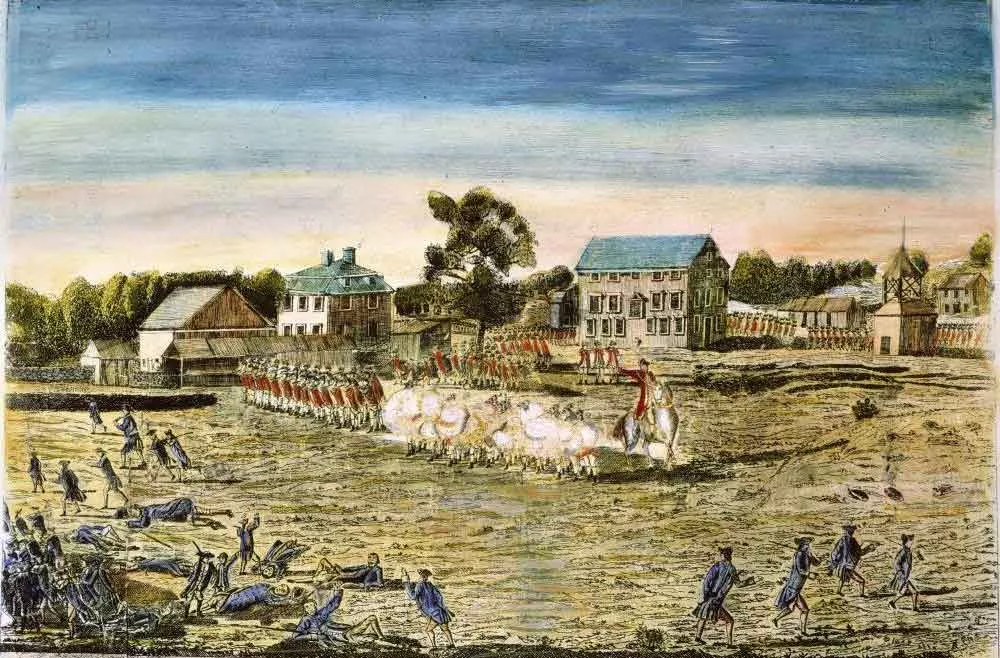The Battles of Lexington and Concord, fought on April 19, 1775, marked the outbreak of the American Revolutionary War. The British, seeking to suppress a growing colonial rebellion, dispatched 700 elite troops under the command of Lieutenant Colonel Francis Smith to seize a stockpile of arms and ammunition in Concord, Massachusetts. News of this impending operation quickly spread through the colonial network, alerting local militias.
The operation began with British troops crossing the Charles River to Cambridge and marching toward Concord under darkness. The confrontation began at Lexington Green, where a small contingent of colonial militiamen, under the command of Captain John Parker, faced a significantly larger British force. As the Regulars approached the town common, Parker told his men to “Stand your ground, don’t fire unless fired upon, but if they mean to have a war, let it begin here!”1 The precise sequence of events remains debated, but a shot from an unknown source was fired as the British troops approached the militia. The Regulars fired at point-blank range into Parker’s company, resulting in the deaths of eight colonial militiamen. Ten additional Lexington men and one British soldier were also wounded during the fight.
Undeterred, the British continued their march to Concord. Upon arrival, Smith sent some of his soldiers across the North Bridge to Barrett Farm, where the stockpile of arms and ammunition was believed to be hidden. Hundreds of minutemen watched the British from a nearby hill. Suddenly, the colonists spotted a plume of thick smoke billowing from the center of town. Unknown to the militia soldiers, this fire was caused by British Regulars burning wood carriages for cannons. Colonel James Barrett ordered his men to march across the North Bridge and protect the town. As they approached the bridge, the Regulars opened fire. Major John Buttrick responded by shouting, “Fire! For God’s sake fire!”2 and the minutemen returned fire. Three British soldiers and two men from the town of Acton, Massachusetts, were killed. An additional nine Regulars were wounded.
Around noon, the British troops withdrew from Concord to return to Boston. However, they encountered fierce resistance from over four thousand colonial militiamen who had converged from surrounding towns. Outnumbered and outmaneuvered, the British were forced to retreat along a perilous route back to Boston, facing a continuous barrage of fire from concealed colonial positions. By the time the British reached Boston, seventy-three soldiers had been killed, one hundred and seventy-four had been wounded, and twenty-six were missing. By comparison, forty-nine colonists were killed, an additional 41 were injured, and five were missing.
The battles demonstrated the effectiveness of colonial militia tactics. The militia’s military capabilities, including rapid movements and hit-and-run tactics, proved a formidable challenge for the more conventional British army.
The legacy of Lexington and Concord extends far beyond the immediate military consequences. These battles became a rallying cry for the growing revolutionary movement. They instilled a sense of national unity among the colonists and fostered a collective determination to fight for independence.
NOTES:
1 Deposition of Sergeant William Munroe, April 25, 1822; Frank Warren Coburn, Battle of April 19, 1775, (Place of publication not identified: Nabu Press, 2010). 2 National Park Service. “Major John Buttrick (U.S. National Park Service),” accessed January 25, 2025, www.nps.gov/people/major-john-buttrick.htm.


